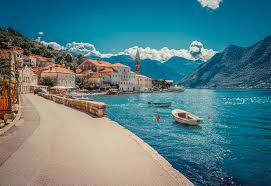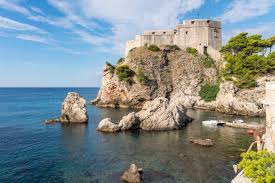Europe is a dream destination for many travelers, especially during the summer months. In this article, we delve into the exciting topic of planning a summer getaway in Europe. Whether you’re seeking a romantic escape, a cultural adventure, or a relaxing beach vacation, Europe offers a plethora of options to suit every traveler’s taste. The purpose of this article is to provide a comprehensive guide to planning a memorable summer trip to Europe, covering various aspects such as choosing the right destinations, creating an itinerary, considering transportation options, and finding the best accommodations. We will explore the appeal and popularity of Europe as a summer destination, highlighting its rich history, stunning landscapes, vibrant cities, and diverse cultural experiences that draw millions of visitors each year. Do you want to spend your summer in Europe? We are going to cover all the best places in this article.
Best Time to Visit Europe in Summer
 When it comes to planning a summer getaway in Europe, timing is crucial. The best time to visit Europe during the summer months is generally between June and September. This period offers pleasant weather with longer days, allowing you to make the most of your trip. However, it’s important to note that the peak tourist season in Europe falls during July and August, which means popular destinations can be crowded, and prices for accommodations and flights may be higher.
When it comes to planning a summer getaway in Europe, timing is crucial. The best time to visit Europe during the summer months is generally between June and September. This period offers pleasant weather with longer days, allowing you to make the most of your trip. However, it’s important to note that the peak tourist season in Europe falls during July and August, which means popular destinations can be crowded, and prices for accommodations and flights may be higher.
To avoid the crowds and enjoy a more affordable experience, consider traveling in June or September when the weather is still favorable, but the tourist crowds are thinner. Keep in mind that specific countries and regions within Europe may have slightly different climate patterns, so it’s always a good idea to research the weather conditions of your desired destinations before finalizing your travel plans.
What are some of the best summer destinations in Europe, or which are the best places to visit in Europe in summer? People also search for the best summer destinations Europe and Europe summer months. Best cheap summer destinations Europe, best places to visit in Europe in august, best places to visit in Europe in June, best places to visit in Europe in July and summer season in Europe in general – We are going to cover all of that.
Discussion of the optimal timing for a summer getaway in Europe
Planning the timing of your summer getaway in Europe requires careful consideration to ensure the best possible experience. While the summer months of June to September generally offer pleasant weather across the continent, it’s important to factor in other aspects such as tourist crowds and pricing.
If you prefer to avoid large crowds and higher prices, consider traveling in June or September. These months fall just outside the peak tourist season, offering a more tranquil atmosphere while still enjoying favorable weather. June provides the added benefit of longer daylight hours, allowing you to make the most of your sightseeing and outdoor activities. What are some of the best places to visit in June Europe?
However, if you don’t mind the bustling crowds and are eager to participate in popular events and festivals, July and August are the peak months for tourism in Europe. During this time, you can immerse yourself in vibrant street festivals, enjoy outdoor concerts, and experience the lively atmosphere of the continent’s most famous cities. Keep in mind that popular destinations such as Rome, Paris, and Barcelona may be crowded during these months, so be prepared for longer queues and make advanced reservations for attractions and accommodations.
Overview of the climate and weather conditions across different regions
Europe boasts a diverse range of climates and weather conditions across its various regions, making it important to consider the weather patterns when planning your summer getaway.
In Southern Europe, countries like Italy, Greece, and Spain experience hot and dry summers. These regions offer ideal beach weather and are perfect for sunbathing and swimming in the Mediterranean Sea. Central European countries such as Germany, Austria, and Switzerland enjoy pleasant temperatures during the summer, making it an excellent time for outdoor activities like hiking, biking, and exploring charming towns. Northern Europe, including countries like Norway, Sweden, and Finland, experiences milder summers with cooler temperatures, providing a refreshing escape from the heat. These are some of the best places in Europe to visit in June.
Coastal regions across Europe, such as the French Riviera, the Amalfi Coast, and the Greek islands, are popular summer destinations due to their beautiful beaches and mild sea breezes. Inland cities like Paris, Rome, and Prague can get quite hot during the summer, but they offer a wealth of cultural attractions and events to explore.
It’s important to note that weather patterns can vary within each region, so it’s advisable to research specific destinations and their climate conditions before finalizing your itinerary. This will help you pack appropriate clothing and plan activities accordingly.
Recommendations for the months that offer pleasant weather and fewer crowds
For those seeking pleasant weather and fewer crowds, traveling to Europe in June or September is highly recommended.
June is an excellent time to visit as the summer season begins, bringing warmer temperatures and longer days. The weather is generally pleasant, allowing you to enjoy outdoor activities and explore popular attractions without feeling overwhelmed by tourist crowds. Additionally, June offers the advantage of festivals and events such as Midsummer celebrations in Scandinavia and the Fête de la Musique in France, where you can experience local culture and traditions.
September is another fantastic option, with mild temperatures and reduced tourist numbers. The summer crowds have dispersed, allowing you to enjoy a more relaxed and intimate experience at popular sights and landmarks. Additionally, September often brings lower hotel rates and flight prices, making it a budget-friendly choice for travelers.
By choosing to travel in these shoulder months, you can strike a balance between favorable weather and a more peaceful travel experience, ensuring a memorable summer getaway in Europe.
Choosing the Perfect European Destinations
 When planning a summer getaway in Europe, selecting the perfect destinations is key to creating a memorable trip. Europe offers a vast array of diverse and captivating cities, charming coastal towns, picturesque countryside, and cultural gems. The ideal European destinations will depend on your personal interests and preferences. Whether you’re drawn to historical landmarks, stunning natural landscapes, culinary delights, or vibrant nightlife, there is a destination in Europe to suit every traveler.
When planning a summer getaway in Europe, selecting the perfect destinations is key to creating a memorable trip. Europe offers a vast array of diverse and captivating cities, charming coastal towns, picturesque countryside, and cultural gems. The ideal European destinations will depend on your personal interests and preferences. Whether you’re drawn to historical landmarks, stunning natural landscapes, culinary delights, or vibrant nightlife, there is a destination in Europe to suit every traveler.
Consider iconic cities like Paris, Rome, or Barcelona for a mix of history, culture, and cosmopolitan vibes. They are the best places to go in Europe in August. Explore the enchanting coastal towns of the Amalfi Coast, the French Riviera, or the Greek islands for breathtaking beaches and seaside charm. Delve into the picturesque countryside of Tuscany, the Scottish Highlands, or the Swiss Alps for a tranquil escape surrounded by nature’s beauty. Research various destinations, their attractions, and what they have to offer to curate a European itinerary that fulfills your travel dreams.
Tips for structuring and organizing your itinerary
Structuring and organizing your itinerary is crucial for maximizing your time and experiences during your summer getaway in Europe. Here are some valuable tips to help you plan a well-structured itinerary:
Prioritize your must-visit destinations: Identify the top destinations or experiences that are the main highlights of your trip. This will serve as a foundation for building the rest of your itinerary.
- Consider travel distances and transportation: Take into account the travel distances between destinations and the available modes of transportation. Optimize your route to minimize travel time and make the most efficient use of transportation options like trains, flights, or buses.
- Allocate sufficient time in each location: Allow ample time in each destination to explore and immerse yourself in the local culture. Avoid cramming too many activities into a limited timeframe, as it can lead to exhaustion and prevent you from fully enjoying each place.
- Balance popular and off-the-beaten-path destinations: While it’s tempting to visit all the well-known tourist hotspots, don’t forget to include some off-the-beaten-path destinations that offer unique experiences and a more authentic feel of the region.
- Research seasonal events and attractions: Find out if there are any special events, festivals, or attractions happening during your visit. Incorporate them into your itinerary to enhance your cultural experiences and make your trip even more memorable.
- Allow for flexibility: While it’s important to have a structured itinerary, leave some room for flexibility. Unexpected opportunities or recommendations from locals or fellow travelers may arise, allowing you to discover hidden gems or take part in spontaneous adventures.
Discussing the duration of the trip and the number of destinations to visit
When determining the duration of your summer getaway in Europe and the number of destinations to visit, it’s essential to strike a balance between exploration and relaxation. Here are some factors to consider:
- Time available: Assess the amount of time you have for your trip. If you have a limited duration, it’s advisable to focus on fewer destinations to avoid rushing through and missing out on experiences. For longer trips, you have the flexibility to cover more ground.
- Pace of travel: Consider your preferred travel pace. Some people enjoy a fast-paced itinerary, hopping from one destination to another, while others prefer a slower, more immersive experience in a smaller number of places. Find the pace that suits your travel style and allows you to savor each destination.
- Travel distances: Europe offers excellent transportation infrastructure, but keep in mind that travel distances can vary significantly. Factor in travel times between destinations to ensure you have sufficient time to explore and avoid spending too much time on the road or in transit.
Other Factors
- Interests and priorities: Determine your travel priorities and interests. If you’re passionate about history and art, you may want to spend more time in cities like Rome, Florence, or Paris. If you’re a nature enthusiast, allocate more time for outdoor activities in regions such as the Swiss Alps or the Norwegian fjords.
- Balance and variety: Aim for a balanced mix of destinations. Include a combination of iconic cities, charming towns, and scenic landscapes to experience the diverse aspects of Europe. This variety adds depth and richness to your trip.
Ultimately, the ideal duration and number of destinations will vary depending on your personal preferences, available time, and budget. Plan a realistic itinerary that allows you to fully enjoy each place without feeling rushed, ensuring a well-rounded and fulfilling summer getaway in Europe.
Strategies for balancing popular attractions with off-the-beaten-path experiences
 Finding a balance between visiting popular attractions and seeking off-the-beaten-path experiences can greatly enhance your summer getaway in Europe. Here are some strategies to achieve this balance:
Finding a balance between visiting popular attractions and seeking off-the-beaten-path experiences can greatly enhance your summer getaway in Europe. Here are some strategies to achieve this balance:
- Research lesser-known attractions: Explore guidebooks, travel blogs, and local recommendations to discover hidden gems and off-the-beaten-path destinations in each location. These places often offer unique cultural experiences, fewer crowds, and a chance to connect with the local community.
- Opt for alternative timing: Consider visiting popular attractions during non-peak hours or on weekdays when the crowds are smaller. This allows you to enjoy these sites with fewer people and have a more immersive experience.
- Explore neighboring areas: While visiting popular attractions, allocate time to explore the surrounding areas. Venture beyond the main sights and discover charming neighborhoods, local markets, and lesser-known landmarks. This way, you can experience the authenticity of the destination and interact with locals.
- Take guided tours or join local experiences: Joining guided tours or local experiences can provide a deeper understanding of the destination while offering a chance to visit lesser-known spots. Local guides often share insider tips and take you off the typical tourist path, unveiling hidden treasures along the way.
- Embrace spontaneity: Allow room for spontaneous detours and unplanned discoveries. Chat with locals, ask for recommendations, and be open to unexpected opportunities. Some of the most memorable experiences can arise from unplanned adventures.
Suggestions for incorporating flexibility and downtime in the schedule
Incorporating flexibility and downtime in your itinerary is essential for a well-rounded and enjoyable summer getaway in Europe. Here are some suggestions to help you achieve a balanced schedule:
- Plan rest days: Allocate specific days in your itinerary for relaxation and downtime. This allows you to recharge, reflect on your experiences, and simply enjoy the atmosphere of your surroundings. Use these days to wander aimlessly, indulge in local cuisine, or pamper yourself at a spa.
- Keep buffer days: Include buffer days in your itinerary to account for unexpected delays or changes in plans. This provides a safety net and prevents stress if any disruptions occur. Use these extra days to explore nearby attractions or revisit favorite places.
- Maintain a flexible mindset: Embrace the idea that not everything needs to be planned to perfection. Allow for flexibility within your schedule to accommodate spontaneous opportunities that may arise during your trip. This could be accepting an invitation from a local to join a cultural event or taking an impromptu day trip to a nearby town recommended by fellow travelers.
Other Suggestions
- Prioritize your interests: Focus on the activities and attractions that truly interest you and align with your travel goals. Avoid overpacking your schedule with too many sights and experiences, as it can lead to exhaustion. Instead, select a few key experiences each day and savor them fully.
- Embrace downtime during transportation: Use travel time between destinations as an opportunity to relax and unwind. Whether you’re on a train, bus, or plane, take advantage of this downtime to read a book, listen to music, or simply enjoy the scenery passing by.
By incorporating flexibility and downtime into your schedule, you’ll have the opportunity to truly immerse yourself in the destinations you visit, maintain a relaxed mindset, and ensure a more enjoyable and balanced summer getaway in Europe.
Practical Considerations for a Summer in Europe Getaway
Planning a summer getaway in Europe involves several practical considerations to ensure a smooth and enjoyable trip. Here are some important factors to keep in mind:
- Travel documents: Check the passport validity requirements for the countries you plan to visit and ensure your passport has sufficient validity. Additionally, familiarize yourself with any visa requirements and obtain the necessary documents in advance.
- Health and safety: Research the healthcare system and consider obtaining travel insurance that covers medical emergencies. Familiarize yourself with any specific health recommendations or vaccinations required for the countries you’ll be visiting.
- Currency and finances: Determine the local currency in each destination and plan accordingly. Inform your bank about your travel plans to avoid any issues with card transactions. Carry a mix of cash and cards, and consider having a backup source of funds.
- Communication: Check your mobile phone’s international roaming options or consider purchasing a local SIM card for affordable communication. Download relevant travel apps, offline maps, and translation tools to assist you during your trip.
Other Considerations
- Transportation: Research transportation options within Europe, such as trains, flights, or buses, and plan your intercity and intra-country travel accordingly. Consider purchasing transportation passes or tickets in advance to save time and money.
- Accommodations: Book accommodations well in advance, especially if you plan to visit popular destinations. Consider a mix of hotels, hostels, or vacation rentals depending on your preferences and budget.
- Another very important consideration before visiting Europe is new travel regulations. ETIAS is a new visa waiver otherwise known as the European Travel Information and Authorization System. The purpose behind ETIAS and it’s creation by European Union was to strengthen and protect its borders, as well as the EU residents and visitors.
- Itinerary and time management: Create a well-structured itinerary that allows for sufficient time in each destination. Prioritize the attractions and activities that interest you the most and allocate time for relaxation and exploration.
- Weather and packing: Research the weather conditions of each destination and pack accordingly. Bring comfortable walking shoes, appropriate clothing for various climates, and essential items like adapters for electrical outlets.
By considering these practical factors and planning in advance, you can ensure a hassle-free and enjoyable summer getaway in Europe.
Important aspects to consider when planning a summer trip
 When planning a summer trip, there are several important aspects to consider to make the most of your experience. Here are some key considerations:
When planning a summer trip, there are several important aspects to consider to make the most of your experience. Here are some key considerations:
- Destination selection: Research and choose destinations that align with your interests, taking into account factors such as weather, cultural attractions, outdoor activities, and local events happening during your travel dates.
- Duration of the trip: Determine how long you can spend on your summer getaway. Consider the number of days you have available and strike a balance between visiting multiple destinations and allowing enough time to truly explore and enjoy each place.
- Budgeting: Set a realistic budget for your trip and allocate funds for accommodations, transportation, activities, meals, and any additional expenses. Research the cost of living in your chosen destinations to estimate daily expenses accurately.
- Weather considerations: Check the weather conditions for your intended destinations during the summer months. Consider factors such as temperature, rainfall, and humidity to pack appropriate clothing and plan outdoor activities accordingly.
- Travel documentation: Ensure that your passport is valid for at least six months beyond your intended departure date. Check visa requirements for the countries you plan to visit and obtain necessary travel documents well in advance. Also, as mentioned above, after next year, there will be new ETIAS requirements as well, on top of other travel requirements.
Guidance on booking flights, accommodations, and transportation
Booking flights, accommodations, and transportation are crucial aspects of planning a summer trip. Here are some guidelines to help you navigate these aspects effectively:
- Flights: Begin searching for flights well in advance to secure the best deals. Use flight comparison websites or consider flexible dates to find the most affordable options. Be flexible with your departure and arrival airports, as nearby airports may offer cheaper fares.
- Accommodations: Research and book accommodations based on your preferences, budget, and location. Compare prices on hotel booking websites, consider alternative options like vacation rentals or hostels, and read reviews to make informed decisions. Book accommodations in advance, especially in popular destinations, to secure the best deals and availability.
- Transportation: Research transportation options within your chosen destinations, including public transportation, car rentals, or guided tours. Consider factors such as convenience, cost, and the nature of your itinerary. Book any necessary transportation passes or tickets in advance to save time and money.
- Flexibility and cancellations: When making bookings, check the cancellation policies and ensure flexibility in case of unexpected changes. Life’s uncertainties may require adjustments to your plans, so having the option to modify or cancel bookings can be beneficial.
- Travel insurance: Consider purchasing travel insurance that covers trip cancellation, medical emergencies, and baggage loss. Review the policy carefully to understand the coverage and exclusions.
Remember to regularly check for any updates or changes in travel restrictions, entry requirements, or safety advisories for your chosen destinations. By carefully managing your bookings and considering these aspects, you can secure the best deals, ensure comfortable accommodations, and have convenient transportation arrangements for your summer trip.
Exploring options for local transportation and getting around within Europe
When traveling within Europe, there are various options for local transportation that can help you navigate your chosen destinations efficiently. Here are some options to consider:
- Public transportation: Most European cities have well-developed public transportation systems, including metros, buses, trams, and trains. These systems offer convenience, cost-effectiveness, and the opportunity to experience local commuting. Purchase travel cards or passes for unlimited rides within a specified period or use individual tickets as needed.
- Trains: Europe has an extensive and efficient train network, making it an excellent option for traveling between cities or countries. High-speed trains, such as the Eurostar or TGV, provide quick connections, while regional trains offer scenic routes through countryside and smaller towns.
- Buses: Bus services, both local and long-distance, are widely available in Europe. They can be a more economical option for traveling between cities or exploring rural areas. Consider booking bus tickets in advance to secure seats, especially during peak travel periods.
- Car rentals: If you prefer more flexibility and independence, renting a car allows you to explore remote areas and off-the-beaten-path destinations at your own pace. Ensure that you are familiar with local driving regulations and consider parking availability and costs in city centers.
- Bicycles and walking: Many European cities are bike-friendly, with dedicated cycling lanes and bike-sharing programs. Renting bicycles or taking walking tours can be a fantastic way to explore city centers and enjoy the local atmosphere.
Tips for managing expenses, currency exchange, and travel insurance
 Managing expenses, currency exchange, and travel insurance are crucial aspects of planning a summer trip to Europe. Here are some tips to help you navigate these areas effectively:
Managing expenses, currency exchange, and travel insurance are crucial aspects of planning a summer trip to Europe. Here are some tips to help you navigate these areas effectively:
- Budgeting: Set a realistic budget for your trip, taking into account accommodations, transportation, meals, activities, and miscellaneous expenses. Research the average cost of living in your chosen destinations to estimate daily expenses accurately.
- Currency exchange: Familiarize yourself with the local currency of each destination and exchange a sufficient amount before your trip. Consider using a reputable currency exchange service or withdrawing cash from ATMs as needed, keeping in mind any associated fees.
- Credit cards and payments: Notify your bank of your travel plans to avoid any issues with your credit or debit cards while abroad. Check if your cards have international transaction fees and consider using cards that offer favorable exchange rates or travel rewards.
- Travel insurance: Purchase travel insurance that provides coverage for trip cancellation, medical emergencies, and baggage loss. Read the policy details carefully, including coverage limits, exclusions, and any additional riders that may be necessary.
- Digital payment options: Many European countries have embraced digital payment methods such as contactless cards and mobile payment apps. Familiarize yourself with these options, and if applicable, set up mobile payment apps for convenience during your trip.
- Keep track of expenses: Maintain a record of your expenses throughout your trip to stay within your budget and have a clear understanding of your spending. Use apps or spreadsheets to track and categorize your expenses.
By carefully managing your expenses, understanding currency exchange options, and having the necessary travel insurance, you can have peace of mind and a smoother financial experience during your summer trip to Europe.
Must-Have Experiences for a Memorable Summer in Europe
A summer trip to Europe offers a myriad of must-have experiences that will make your journey truly unforgettable. Here are some essential experiences to consider:
- Explore iconic landmarks: Visit world-famous landmarks such as the Eiffel Tower in Paris, the Colosseum in Rome, or the Acropolis in Athens. Marvel at their architectural grandeur and learn about their historical significance.
- Wander through charming old towns: Get lost in the narrow, cobblestone streets of European old towns, like the Gamla Stan in Stockholm or the Old Town in Prague. Experience the medieval charm, admire the colorful buildings, and indulge in local cuisine.
- Delight in local cuisine: Sample the diverse culinary offerings across Europe. Indulge in Italian pizza and pasta, French pastries, Spanish tapas, Belgian chocolates, and so much more. Don’t forget to pair your meals with regional wines and beers.
- Soak in natural beauty: Experience Europe’s stunning natural landscapes, from the picturesque fjords of Norway to the breathtaking cliffs of the Amalfi Coast. Explore national parks, hike through scenic trails, and relax on pristine beaches.
More Travel Tips
- Attend cultural festivals: Immerse yourself in the vibrant cultural festivals that take place during the summer months. From the Running of the Bulls in Pamplona to the Edinburgh Festival Fringe, these events showcase Europe’s rich traditions, music, art, and performances.
- Take scenic train journeys: Embark on scenic train journeys like the Glacier Express in Switzerland, the Cinque Terre route in Italy, or the Ring of Kerry in Ireland. Sit back, relax, and soak in the panoramic views of Europe’s stunning landscapes.
- Cruise along picturesque rivers: Experience the charm of European river cruises, whether it’s a leisurely trip along the Danube, a romantic cruise on the Seine, or a journey through the enchanting canals of Amsterdam.
- Engage in outdoor activities: Enjoy outdoor adventures such as hiking in the Swiss Alps, biking through the Dutch countryside, or kayaking along the Croatian coastline. Europe offers a multitude of thrilling activities for outdoor enthusiasts.
These must-have experiences will allow you to create lasting memories and fully immerse yourself in the diverse culture, history, and natural beauty that Europe has to offer during your summer getaway.
Highlighting unique experiences to enhance the summer getaway
To enhance your summer getaway in Europe, consider seeking out unique experiences that go beyond the usual tourist attractions. Here are some recommendations to add a touch of novelty and authenticity to your trip:
- Local cultural experiences: Immerse yourself in the local culture by participating in unique traditions or events. Attend a traditional Flamenco performance in Spain, join a folk dance festival in the Balkans, or witness a Viking reenactment in Scandinavia. These experiences offer a deeper understanding of the region’s heritage and provide an opportunity to interact with locals.
- Offbeat tours: Opt for alternative and offbeat tours that take you off the well-trodden path. Embark on street art tours in Berlin, underground city tours in Edinburgh, or culinary walking tours in Lisbon. These specialized tours provide a different perspective and allow you to discover hidden gems that are often overlooked.
- Eco-conscious activities: Engage in eco-conscious activities that promote sustainability and appreciation for the environment. Join beach clean-ups, explore sustainable farms and vineyards, or take part in eco-hiking tours that focus on conservation and wildlife preservation.
- Local workshops and classes: Enhance your cultural understanding by participating in workshops or classes that showcase local traditions. Learn how to make traditional pottery in Tuscany, take a cooking class to master regional dishes, or try your hand at traditional crafts like glassblowing in Murano, Italy.
- Historical reenactments: Attend historical reenactments or living history events to step back in time and witness significant historical moments come to life. From medieval jousting tournaments to Renaissance fairs, these events offer a unique glimpse into the past.
Recommendations for cultural festivals, outdoor activities, and local cuisine
 To fully immerse yourself in the cultural tapestry of Europe during your summer getaway, consider these recommendations for cultural festivals, outdoor activities, and local cuisine:
To fully immerse yourself in the cultural tapestry of Europe during your summer getaway, consider these recommendations for cultural festivals, outdoor activities, and local cuisine:
Cultural Festivals: Attend renowned cultural festivals such as the Edinburgh Festival Fringe in Scotland, La Tomatina in Spain, or Oktoberfest in Germany. These festivals celebrate music, arts, cuisine, and local traditions, providing a vibrant and festive atmosphere.
Outdoor Activities: Engage in thrilling outdoor adventures like paragliding in the Swiss Alps, hiking the Cinque Terre trails in Italy, or kayaking along the Dalmatian coast in Croatia. Europe offers a wide range of activities for nature enthusiasts, allowing you to explore its breathtaking landscapes.
Local Cuisine: Indulge in the diverse and delectable local cuisine across Europe. Sample fresh seafood in coastal regions, savor hearty stews and sausages in central Europe, or delight in the delicate pastries and chocolates of France and Belgium. Don’t forget to pair your meals with regional wines, beers, or spirits for a complete culinary experience.
Wine and Food Festivals: Attend wine and food festivals that celebrate the region’s culinary delights. Experience the Bordeaux Wine Festival in France, the Truffle Festival in Italy, or the St. Patrick’s Day Festival in Ireland, which showcases traditional Irish cuisine.
Music and Arts Events: Immerse yourself in the rich music and arts scene by attending renowned events like the Salzburg Festival in Austria, the Montreux Jazz Festival in Switzerland, or the Glastonbury Festival in England. These events offer an eclectic mix of performances, from classical concerts to contemporary music and art installations.
By exploring unique experiences, attending cultural festivals, engaging in outdoor activities, and savoring local cuisine, you can enhance your summer getaway in Europe and create lifelong memories of your travels.
Mentioning popular summer events and celebrations in various countries
Summer in Europe is a vibrant time filled with exciting events and celebrations that showcase the diverse cultures of each country. Here are some popular summer events and celebrations to consider:
Running of the Bulls (Pamplona, Spain): Experience the adrenaline-pumping Running of the Bulls during the San Fermín Festival in July. Watch as brave participants run alongside the bulls through the streets of Pamplona.
Edinburgh Festival Fringe (Edinburgh, Scotland): Immerse yourself in the world’s largest arts festival in August. The Edinburgh Festival Fringe features thousands of performances, including theater, comedy, music, and dance. It is one of the best places to visit in Europe in august 2023.
Montreux Jazz Festival (Montreux, Switzerland): Enjoy world-class music at the Montreux Jazz Festival, held in July. Experience jazz, blues, rock, and pop performances by renowned artists in a stunning lakeside setting.
Carnival (Venice, Italy): Delve into the magical atmosphere of the Venice Carnival, which takes place in February. Experience the elaborate masks, stunning costumes, and vibrant parades that bring the city to life.
Tomorrowland (Boom, Belgium): Join the world’s largest electronic dance music festival in July. Tomorrowland attracts top DJs and electronic music enthusiasts from around the globe for an unforgettable party experience.
Encouraging readers to immerse themselves in the local culture and traditions
 To truly make the most of a summer getaway in Europe, it’s essential to immerse yourself in the local culture and traditions of each destination. Here’s why it’s worth embracing:
To truly make the most of a summer getaway in Europe, it’s essential to immerse yourself in the local culture and traditions of each destination. Here’s why it’s worth embracing:
Authentic experiences: Immersing yourself in local culture allows you to go beyond the tourist façade and discover the genuine essence of a place. Interacting with locals, participating in traditions, and trying local activities provide authentic experiences that deepen your understanding of the destination.
Cultural appreciation: Engaging with local culture and traditions fosters an appreciation for different ways of life. It allows you to gain insights into the history, art, music, and culinary heritage of the region, promoting cross-cultural understanding and respect.
Unique encounters: Embracing local customs opens doors to unique encounters and connections. Engaging in conversations with locals, attending cultural events, or visiting traditional markets can lead to memorable interactions and forge lifelong connections.
Enhanced travel experiences: Immerse yourself in the local culture, and you’ll discover hidden gems that might not be featured in guidebooks. From off-the-beaten-path restaurants to tucked-away neighborhoods, embracing local culture enriches your travel experiences.
Lasting memories: Participating in local traditions and events creates lasting memories that stay with you long after your trip ends. Immersing yourself in the local culture allows you to create meaningful connections and moments that become cherished parts of your travel experience.
By immersing yourself in the local culture and traditions of each destination, you’ll deepen your travel experience, gain a greater appreciation for the region, and create unforgettable memories that will enrich your summer getaway in Europe.
Tips to consider
- Places to visit in Europe in August: Some popular destinations to visit in August include Barcelona, Spain; Santorini, Greece; Dubrovnik, Croatia; Amsterdam, Netherlands; and Paris, France.
- Summer Europe trip: A summer trip to Europe offers a wide range of experiences. Explore iconic cities like Rome, Paris, and London, relax on the beaches of the French Riviera or Greek islands, and immerse yourself in the rich history and culture of countries like Italy, Spain, and Germany.
- Best places to visit in July Europe: In July, consider visiting destinations such as Prague, Czech Republic; Budapest, Hungary; Lisbon, Portugal; Copenhagen, Denmark; and Stockholm, Sweden for pleasant weather, cultural attractions, and vibrant summer festivals.
- Summer sun destinations in Europe: The Mediterranean coast offers fantastic summer sun destinations, including the French Riviera, Amalfi Coast, Costa del Sol, Greek islands, and the Algarve region in Portugal. These destinations offer beautiful beaches, warm weather, and a relaxed coastal ambiance.
- Best places in Europe to visit in summer: Europe is filled with incredible summer destinations. Some popular choices include Santorini, Barcelona, Rome, Paris, Dubrovnik, London, Amsterdam, Florence, and the Greek islands like Mykonos and Crete.
- Best summer places in Europe: Some of the best summer places in Europe include the French Riviera, Ibiza, the Amalfi Coast, Greek islands like Santorini and Mykonos, Croatia’s Dalmatian Coast, the Swiss Alps, the Scottish Highlands, and the Norwegian fjords.
- Summer city breaks Europe: For short city breaks in Europe during summer, consider destinations like Barcelona, Rome, Prague, Lisbon, Budapest, Vienna, Krakow, Amsterdam, Copenhagen, and Edinburgh. These cities offer a mix of history, culture, and vibrant summer vibes.
Additional Tips
- Cheap destinations in Europe summer: Some affordable summer destinations in Europe include Budapest, Prague, Krakow, Lisbon, Warsaw, Athens, Sofia, Belgrade, Riga, and Tallinn. These cities offer a rich cultural experience at a more budget-friendly price.
- Most beautiful places in Europe summer: Europe boasts numerous stunning places in summer. Some of the most beautiful destinations include the Amalfi Coast, the French Riviera, Santorini, the Swiss Alps, the Norwegian fjords, the Cinque Terre in Italy, the Plitvice Lakes in Croatia, and the Scottish Highlands.
- Travel to Europe this summer: Traveling to Europe this summer offers endless possibilities. Whether you seek historical landmarks, vibrant cities, breathtaking landscapes, or picturesque coastal towns, Europe has it all. Research the entry requirements, plan your itinerary, and get ready for an unforgettable summer adventure.
- Best places to go in Europe in summer: There are countless great places to visit in Europe during summer. Some top choices include Paris, Rome, Barcelona, London, Amsterdam, Santorini, Mykonos, Florence, Prague, and the Croatian coast.
- Europe summer itinerary: An ideal summer itinerary in Europe could include starting in London, then visiting Paris, Rome, Florence, the Greek islands, Barcelona, and ending in Amsterdam. This itinerary offers a mix of iconic cities, cultural experiences, and stunning coastal landscapes.
- Best summer vacations in Europe: Europe offers a wide range of best summer vacations. Consider destinations like the French Riviera, Greek islands, Italian cities, Spanish coastal towns, Scandinavian countries, and the Swiss Alps for unforgettable summer getaways.
